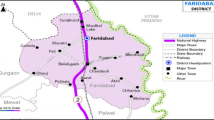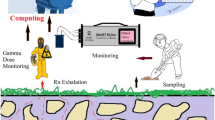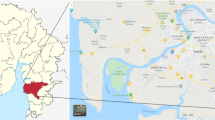Abstract
The measurements of radon/thoron exhalation rates from soil are useful to know high risk potential area from the view point of health effects. The exhalation rates have been estimated in 50 soil samples taken from Barnala and Moga districts of Punjab, India using scintillation based detector, Smart RnDuo. Soil samples have been collected using grid pattern of 6 × 6 km2 for uniform mapping of the area. The radon mass exhalation rates have been found to vary from 4.56 ± 0.53 to 41.13 ± 1.21 mBqkg−1 h−1 with an average value of 24.8 ± 1 mBqkg−1 h−1 which are lower than the worldwide average value of 57 mBqkg−1 h−1. The thoron surface exhalation rates lie in the range from 1.50 ± 0.63 to 23.77 ± 1.52 kBqm−2 h−1 with mean value of 15.62 ± 1.24 kBqm−2 h−1 which are higher than worldwide average value of 3.60 kBqm−2 h−1 as reported by UNSCEAR 2000. These exhalation rates are indicative of less radon levels in this study area.






Similar content being viewed by others
Data availability
Not Applicable.
References
Sahoo BK, Sapra BK, Gaware JJ, Kanse SD, Mayya YS (2011) A model to predict radon exhalation from walls to indoor air based on the exhalation from building material samples. Sci Total Environ 409:2635–2641
UNSCEAR United Nations Scientific Committee on the Effects of Atomic Radiation (2000) Sources and effects of ionizing radiation. Report to the general assembly, United Nation, New York
WHO (2009) Indoor Radon a Public Health Perspective. Public Health Perspective
Jakhu R, Mehra R, Bangotra P, Kaur K, Mittal HM (2017) Estimation of terrestrial radionuclide concentration and effect of soil parameters on exhalation and emanation rate of radon. Journal of Geochemical Exploration xxx:xxx-xxx
Sahoo BK, Nathwani D, Eappen KP, Ramachandran TV, Gaware JJ, Mayya YS (2007) Estimation of radon emanation factor in Indian building materials. Radiat Meas 42(8):1422–1425
Mayya YS, Eappen KP, Nimbi KSV (1998) Methodology for mixed field inhalation dosimetry in monazite areas using a twin- cup dosimeter with three track detectors. Radiat Prot Dosim 77(3):177–184
Chen J, Rahman NM, Atiya IA (2010) Radon exhalation from building materials for decorative use. J Environ Radioact 10(4):317–322
Antonopoulos-Domis M, Kritidis P, Raptis C (1998) Diffusion model of radon exhalation rates. Health Phys 74(5):574–580
Hassan NM, Ishika T, Hasoda M, Iwoka L, Sorimachi A, Sahoo SK, Janik M, Kranrod C, Yonehara H, Fukushi M, Tokonami S (2011) The effect of water content on the radon emanation coefficient of some building materials used in Japan. Radiat Meas. https://doi.org/10.1016/j.radmeas.2010.11.006
Keller G, Hoffman B, Fiegenspan T (2001) Radon permeability and radon exhalation of building materials. Sci Total Environ 272:85–89
Esan DT, Sridha MKC, Obed R, Ajiboye Y, Afolabi O, Olubodun B, Oni OM (2020) Determination of residential soil gas risk indices over the lithological units of a southwestern Nigeria University. Sci Rep. https://doi.org/10.1038/s41598-020-64217-8
Tanner AB (1980) Radon migration in ground: A supplement review. In the natural radiation environment III (eds. T.F. Gesell and W.M. Lowder). National Technical information service, spring field, V.A. CONF- 780422, 5-56
Kumar A, Kaur A (2014) A study of radon concentration in water and radon exhalation rate in soil samples belonging to Kapurthala district, Punjab, India. Adv Appl Sci Res 5(1):43–47
Singla AK, Kansal S, Mehra R (2021) Quantification of radon contamintaion in drinking water of Rajasthan, India. J Radioanal Nucl Chem 327(3):1149–1157
Nazir S, Simnani S et al (2020) Simultaneous measurement of radon, thoron and their progeny for inhalation dose assesssment in indoors of Srinagar, J&K, India. J Radioanal Nucl Chem 325:315–328
Butterweck G, Schuler Ch, Vezzu G, Muller R, Marsh JW, Thrift S, Birchall A (2002) Experimental determination of the absorption rate of unattached radon progeny from respiratory tract to blood. Radiat Prot Dosim 102(4):343–348
EL-Hussein A, Ahmed AA, Mohammad A (1998) Radiation dose to the human respiratory tract from inhalation of radon-222 and its progeny. Applied Radiat Isot 49(7): 783-790
ICRP (2011) Radiological protection against radon exposure. ICRP ref 4829-9671-6554
Mehra R, Singh S, Singh K (2006) A study of uranium, radium, radon exhalation rate and indoor radon in the envrirons of some areas of the Malwa region, Punjab. https://doi.org/10.1177/140326X6069053
Chahuan RP, Kumar A, Chauhan N, Joshi M, Aggarwal P, Sahoo BK (2014) Ventilation effect on indoor radon-thoron levels in the dwellings and correlation with soil exhalation rates. Indoor Inbuilt Original Paper Environ 25(1):203–212
Kansal S, Mehra R, Singh NP (2011) Uranium concentration in groundwater samples belonging to some areas of Western Haryana, India using Fission track registration technique. J Public Health Epidemiol 3(8):352–357
Singla AK, Kansal S, Rani S, Mehra R (2021) Radiological risk assessment due to attached/unattached fractions of radon and thoron progeny in Hanumangarh district, Rajasthan. Journal of Radioanalytical and Nuclear Chemistry https://doi.org/10.1007/s10967-021-07930-6
Darby S, Hill D, Auvinen A, Barros-Dios JM, Baysson H, Bochicchio F, Deo H, Falk R, Forastiere R, Hakama M, Heid I, Kreienbrock L, Kreuzer M, Lagarde L, Mäkeläinen I, Muirhead C, Oberaigner W, Pershagen G, Ruano-Ravina A, Ruosteenoja E, Schaffrath Rosario E, Tirmarche M, TomáBek L, Whitley E, Wichmann HE, Doll R (2005) Radon in homes and risk of lung cancer: collaborative analysis of individual data from 13 European case-control studies. Br Med J 330(7485):223–226
Krewski D, Lubin JH, Zielinski JM, Alavanja M, Catalan VS, Field RW, Klotz JB, Létourneau EG, Lynch CF, Lyon JI, Sandler DP, Schoenberg JB, Steck DJ, Stolwijk JA, Weinberg C, Wilcox HB (2005) Residential radon and risk of lung cancer: a analysis of 7 North American case control studies. Epidemiology 16(2):137–145
Lubin JH, Boice D Jr, Edling JC, Hornung RW, Howe GR, Kunz E, Kusiak RA, Morrison HI, Radford EP, Samet JM, Tirmarche M, Woodward A, Yao SX, Pierce DA (1995) Lung cancer in radon-exposed miners and estimation of risk from indoor exposure. J Nat Cancer Inst 87(11):817–827
Lubin JH, Boice D Jr (1997) Lung cancer risk for residential radon: Meta-analysis of eight epidemiologic studies. J Nat Council Inst 89(1):49–57
Richcardson RB, Eatough JP, Henshaw DL (1991) Dose to red bone marrow from natural radon and thoron exposure. Br J Radiol 1(64):608–624
Mehra R, Bhagotra P, Kaur K (2015) Radon and thoron levels of Mansa and Mukutsar district of Punjab, India. Front Environ Sci 3:37
Rani S, Kansal S, Singla AK, Mehra R (2021) Radiological risk assessment to the public due to the presence of radon in water of Barnala district, Punjab, India. Environ Geochem health. https://doi.org/10.1007/s10653-021-01012-y
BEIR (VI), (1999) Report of committee on biological effects of ionizing radiation, health effect of exposure to radon. Natl Res Council Natl Acad Press, Washington, DC, p 2
Agency for toxic substances and disease regulator agency (ATSDR) (1999) Report TP- 90-29. Atlana, USA
Sonkawde RG, Ram R (2003) Radon in Tube-well drinking water and indoor air. Indoor Built Environ 13:383–385
Singla AK, Kansal S, Mehra R (2021) Dose distribution to individual tissues and organs due to exposure of alpha energies from radon and thoron to local population of Hanumangarh, Rajasthan, India. J Radioanal Nucl Chem 327(3):1073–1085
Fardoas S, Saleh A, BadriahBerzan A (2007) Measurement of natural radioactivity in some kinds of marble and granite used in Riyadh region. J Nucl Rad Phys 2:25–536
Bangotra P, Jakhu R, Mehra R (2017) Estimation of radon exhalation rate and assessment of radiological risk from the activity concentration of Ra-226, Th-232 and K-40. Journal of Geochemical exploration XX
Sapra BK, Sahoo BK, Mishra R et al (2010) Handbook on radon transport models and measurement methods developed by BARC. RPAD, Health Safety and Environment Group, BARC, Mumbai, 51
Eappen KP, Sahoo BK, Ramchandran TV, Mayya YS (2008) Calibration factor for thoron estimation in cup dosimeter. Radiat Meas 43(1):S418–S421
Gaware JJ, Sahoo BK, Sapra BK, Mayya YS (2011) Indigenous development and networking of online radon monitors in the underground uranium mine. Radiat Prot Environ 34:37–40
Tokonami S, Young M, Yonehara H (2002) Simple discriminative measurement techniques ifor radon and thoron concentrations with a single scintillation cell. Rev Sci Instrum 73:69. https://doi.org/10.1063/1.141621
Sahoo BK, Sapra BK, Kanse SD, Gaware JJ, Mayya YS (2013) A new pinhole discriminated 222Rn/220 Rn passive measurement device with single entry face. Radiat Meas 58:52–60
Mishra UC (1972) Natural and fallout gamma nuclides in Indian soils. In: Natural radiation environment- II, vol 1, USERDA, CONF-720805-P2, p 333
Sankaran AV, Jayaswal B, Nambi KSV (1986) U, Th and K distributions inferred from regional geology and terrestrial radiation profile in India. Technical report, BARC 53
Ramachandran TV, Sahoo BK (2009) Thoron (220Rn) in indoor environment and work places. Indian J Phys 83(8):1079–1098
Prajith R, Rout RP, Kumbhar D et al (2019) Measurements of radon (222Rn) and thoron (220Rn) exhalations and their decay products concentrations at Indian stations in Antarctica. Environ Earth Sci. https://doi.org/10.1007/s12665-018-8029-7
Gusain GS, Prasad G, Prasad Y, Ramola RC (2009) Comparison of indoor radon level with radon exhalation rate from soil in Garhwal Himalaya. Radiat Meas 44:1032–1035
Bala P, Kumar V, Mehra R (2017) Measurement of radon exhalation rate in various building materials and soil samples. J Earth Syst Sci. https://doi.org/10.1007/s12040-017-0797-z
Yadav M, Prasad M, Joshi V, Gusain GS, Ramola RC (2016) A comparative study of radium content and radon exhalation rate from soil samples using active and passive techniques. Radiation Protection and Dosimetry 1–3
Kaur M, Kumar A, Kaur S, Kaur K (2018) Assessment of radon/ thoron exhalation rate in the soil samples of Amritsar and Tarn Taran district of Punjab state. Radiat Prot Environ 41(4):210
Kansal S, Mehra R (2015) Evaluation and Analysis of Ra-226, Th-232, K-40 and Rn-222 exhalation rate in the soil samples for health risk assessment. Int J Low Rad 10(1):1–13
Nagaraju KM, Chandershekara MS, Rani KSP, Rajesh BM, Paramesh L (2013) Radioactivity measurement in the environment of Chamrajanagar area, India. Radiation protection and environment 36:(1)
Singh B, Kant K, Garg M, Sahoo BK (2020) Quantification of radon/thoron exhalation rates of soil samples collected from district Faridabad of Southern Haryana, India. Journal of Radioanalytical and Nuclear Chemistry. https://doi.org/10.1007/s10967-020-07365-5
Choudhary AK (2014) Measurement of radon activity and exhalation rate from soil samples from Banda district, India. Radiation protection and environment 37(3&4)
Acknowledgements
The authors appreciate the residents of the study areas for their support in carrying out field work for sample collection.
Funding
Self-Financed.
Author information
Authors and Affiliations
Contributions
Supriya Rani and Sandeep Kansal have designed the research plan and prepared the manuscript with contribution of Amit Kumar Singla, Salik Nazir and Rohit Mehra. Supriya Rani and Salik Nazir generated all the figures and tables in the manuscript. Supriya Rani carried out all the field work for sample collection and analysis in the lab. All authors have read and approved the final manuscript.
Corresponding author
Ethics declarations
Conflict of interest
On behalf of all authors, the corresponding author states that there is no conflict of interest.
Animal research
Not Applicable.
Consent to participate
Not Applicable.
Consent to publish
All authors have read and approved the final manuscript.
Additional information
Publisher's Note
Springer Nature remains neutral with regard to jurisdictional claims in published maps and institutional affiliations.
Rights and permissions
About this article
Cite this article
Rani, S., Kansal, S., Singla, A.K. et al. A comprehensive study of exhalation rates in soil samples to understand the high-risk potential area in Barnala and Moga districts of Punjab, India. J Radioanal Nucl Chem 331, 1889–1897 (2022). https://doi.org/10.1007/s10967-021-08129-5
Received:
Accepted:
Published:
Issue Date:
DOI: https://doi.org/10.1007/s10967-021-08129-5




